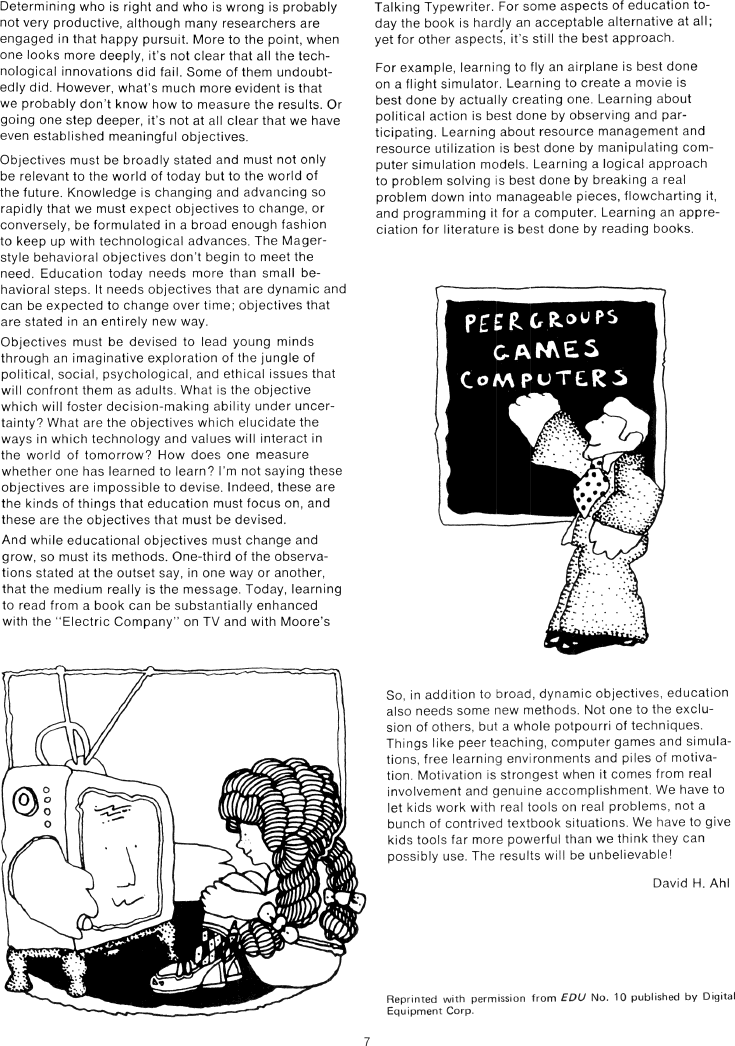The Best of Creative Computing Volume 1 (published 1976)
What's Wrong With the Little Red Schoolhouse?

Determining who is right and who is wrong is probably not very productive,
although many researchers are engaged in that happy pursuit. More to the point,
when one looks more deeply, it's not clear that all the technological
innovations did fail. Some of them undoubtedly did. However, what's much more
evident is that we probably don't know how to measure the results. Or going one
step deeper, it's not at all clear that we have even established meaningful
objectives.
Objectives must be broadly stated and must not only be relevant to the world of
today but to the world of the future. Knowledge is changing and advancing so
rapidly that we must expect objectives to change, or conversely, be formulated
in a broad enough fashion to keep up with technological advances. The Magerstyle
behavioral objectives don't begin to meet the need. Education today needs more
than small behavioral steps. It needs objectives that are dynamic and can be
expected to change over time; objectives that are stated in an entirely new way.
Objectives must be devised to lead young minds through an imaginative
exploration of the jungle of
political, social, psychological, and ethical issues that will confront them as
adults. What is the objective
which will foster decision-making ability under uncertainty? What are the
objectives which elucidate the
ways in which technology and values will interact in the world of tomorrow? How
does one measure
whether one has learned to learn? l'm not saying these objectives are impossible
to devise. Indeed, these are the kinds of things that education must focus on,
and these are the objectives that must be devised.
And while educational objectives must change and grow, so must its methods.
One-third of the observations stated at the outset say, in one way or another,
that the medium really is the message. Today, learning to read from a book can
be substantially enhanced with the "Electric Company" on TV and with Moore's
Talking Typewriter. For some aspects of education today the book is hardly an
acceptable alternative at all; yet for other aspects, it's still the best
approach.
For example, learning to fly an airplane is best done on a flight simulator.
Learning to create a movie is
best done by actually creating one. Learning about political action is best done
by observing and participating. Learning about resource management and resource
utilization is best done by manipulating computer simulation models. Learning a
logical approach to problem solving is best done by breaking a real problem down
into manageable pieces, flowcharting it, and programming it for a computer.
Learning an appreciation for literature is best done by reading books.
So, in addition to broad, dynamic objectives, education also needs some new
methods. Not one to the exclusion of others, but a whole potpourri of
techniques. Things like peer teaching, computer games and simulations, free
learning environments and piles of motivation. Motivation is strongest when it
comes from real involvement and genuine accomplishment. We have to let kids work
with real tools on real problems, not a bunch of contrived textbook situations.
We have to give kids tools far more powerful than we think they can possibly
use, The results will be unbelievable!
David H. Ahl
Reprinted with permission from EDU No. 10 published by Digital Equipment Corp.


